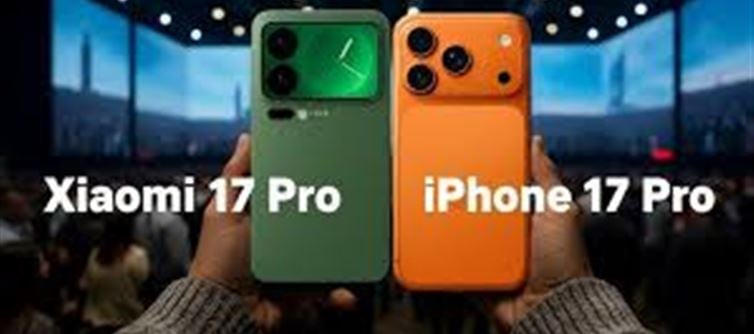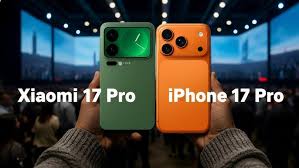
In a world where smartphone brands constantly push the envelope on innovation and pricing, xiaomi has set the stage for a fierce battle with apple by unveiling its flagship Xiaomi 17 Pro and Xiaomi 17 Pro Max series. With aggressive pricing, a powerful Snapdragon 8 Elite Gen 5 chipset, and a focus on delivering high-end features at competitive prices, xiaomi is making a bold statement against Apple’s iPhone 17 series, which was recently launched. Here’s a closer look at how these two powerhouses stack up against each other in the Chinese market.
1. Aggressive Pricing: Xiaomi’s Strategy to Capture Market Share
One of the most significant factors contributing to Xiaomi’s growing success is its affordable pricing for high-end specifications. With the Xiaomi 17 Pro and Pro Max, the company has once again undercut apple, offering flagship-level features at a fraction of the cost of the iPhone 17 series.
· Xiaomi 17 Series Pricing:
o Xiaomi 17 Pro: Starts at CNY 4,999 (approx. $685)
o Xiaomi 17 Pro Max: Starts at CNY 5,999 (approx. $825)
· iPhone 17 Series Pricing:
o iPhone 17: Starts at CNY 7,999 (approx. $1,095)
o iPhone 17 Pro: Starts at CNY 9,999 (approx. $1,370)
Xiaomi’s affordable pricing puts it in a direct collision course with apple, offering consumers flagship specs at a considerably lower price point, which could disrupt the premium market in China.
2. Snapdragon 8 Elite Gen 5 vs apple A17 Bionic: The Battle of Chips
Both smartphones boast top-of-the-line chips designed to enhance performance, battery efficiency, and AI capabilities, but the competition is fierce.
· Xiaomi 17 Pro and Pro Max:
o Powered by the Snapdragon 8 Elite Gen 5 chipset, this processor offers improved AI performance, better energy efficiency, and blistering-fast speeds. Paired with Adreno 740 GPU, it promises seamless gaming and multitasking performance.
o Key Features:
§ AI-enhanced camera processing
§ Enhanced power efficiency for extended battery life
§ Optimized gaming performance with high frame rates and better heat management
· iPhone 17 Series:
o Equipped with Apple’s A17 Bionic chip, which continues Apple’s streak of high-performance processors. The A17 is built on a 3nm process, making it not only faster but also more power-efficient. The A17 Bionic offers better machine learning, photography enhancements, and gaming performance.
o Key Features:
§ Superior machine learning capabilities with Core ML
§ Immersive graphics performance for gaming and AR
§ Efficient power management for long-lasting battery life
While Snapdragon 8 Elite Gen 5 delivers a strong challenge to the A17, Apple's chip is still renowned for its performance in both CPU and GPU tasks, giving it a slight edge in overall efficiency.
3. Camera Technology: Xiaomi’s Focus on Versatility vs iPhone’s Premium Lens
Both brands are pushing the envelope with camera technology. xiaomi is leveraging its high megapixel sensors and advanced AI features, while apple continues to improve its proprietary camera software and sensor technology.
· Xiaomi 17 Pro and Pro Max:
o Triple-Camera Setup (Pro Max model)
o 200 mp Main Camera with AI-enhanced shooting modes
o Ultra-wide and Telephoto lenses offering improved zoom and night photography
o Advanced AI video stabilization for smooth recording
· iPhone 17 Series:
o 48 mp Main Camera with sensor-shift optical image stabilization
o Ultra-wide and telephoto lenses
o Apple's famous Photonic Engine for improved low-light performance
o ProRAW and ProRes for professional-grade photo and video capture
While the Xiaomi 17 Pro Max offers an impressive 200 mp main sensor, Apple’s camera software and image processing algorithms continue to set the bar for real-world photo quality, especially in terms of natural color reproduction and dynamic range.
4. Display and Design: Xiaomi’s Bold Innovation vs iPhone’s Premium Build
When it comes to displays, both brands are offering beautiful, high-quality screens, but their approach is slightly different.
· Xiaomi 17 Pro and Pro Max:
o 6.73-inch AMOLED display with 120 Hz refresh rate
o 1200 nits peak brightness for vibrant colors and clear visibility in direct sunlight
o Curved edge design for a modern, flagship look
· iPhone 17 Series:
o 6.1-inch Super Retina XDR OLED with ProMotion 120Hz refresh rate
o 2,000 nits peak brightness for exceptional outdoor viewing
o Ceramic shield front cover, providing a premium and durable build
While both phones offer top-tier displays, Apple’s OLED screen is typically regarded for its accuracy and sharpness, while xiaomi aims for a more immersive experience with curved edges and better contrast ratios.
5. Battery Life: Xiaomi's Efficiency vs iPhone’s Battery Management
Battery life is a crucial factor in choosing a flagship, and both xiaomi and apple have made significant strides in this department.
· Xiaomi 17 Pro and Pro Max:
o 4,800mAh (Pro) and 5,000mAh (Pro Max) batteries
o 120W fast charging that can charge the phone to 100% in under 20 minutes
o Wireless charging and reverse charging features
· iPhone 17 Series:
o Battery optimization through iOS and the A17 Bionic chip
o MagSafe wireless charging and fast charging capabilities
o Slightly smaller battery capacity but excellent battery life thanks to Apple’s power management algorithms
Xiaomi’s fast charging and larger battery sizes might be a huge draw for power users, while iphone continues to optimize its battery performance for long-lasting use.
6. software & Ecosystem: Xiaomi's MIUI vs Apple's iOS
The software experience is another differentiating factor. xiaomi uses MIUI (a customized version of Android), while apple sticks to iOS, renowned for its smooth integration and security features.
· Xiaomi 17 Series:
o MIUI 15 with AI-driven features and customization options
o Better integration with Xiaomi’s ecosystem (smart home devices, wearables, etc.)
· iPhone 17 Series:
o iOS 17 with advanced privacy features and seamless integration into the apple ecosystem (iCloud, AirPods, MacBooks, etc.)
While both ecosystems have their strengths, Apple’s iOS continues to dominate in terms of long-term software support and app ecosystem, while Xiaomi’s MIUI offers a more customizable experience for those who prefer control over their device.
Conclusion: The Stakes Are High in China
With aggressive pricing, advanced chipset technology, and innovative features, the Xiaomi 17 Pro and Pro Max are certainly raising the stakes for the iPhone 17 series in China. Xiaomi’s challenge lies in offering cutting-edge specifications at a more affordable price, while apple continues to rely on its premium brand image and ecosystem to retain its loyal following.
The competition is fierce, and it will be interesting to see how this battle for supremacy plays out in the coming months as both brands look to dominate the Chinese smartphone market.
Disclaimer:
The views and opinions expressed in this article are those of the author and do not necessarily reflect the official policy or position of any agency, organization, employer, or company. All information provided is for general informational purposes only. While every effort has been made to ensure accuracy, we make no representations or warranties of any kind, express or implied, about the completeness, reliability, or suitability of the information contained herein. Readers are advised to verify facts and seek professional advice where necessary. Any reliance placed on such information is strictly at the reader’s own risk.





 click and follow Indiaherald WhatsApp channel
click and follow Indiaherald WhatsApp channel